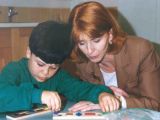A previous study based on visual experiments has hinted that autism is a consequence of the failure of brain areas to work together. The theory, called the theory of underconnectivity, accounts for observations that while many people with autism excel at tasks involving details, they have difficulty with more complex information.
This idea was now confirmed by another study that focused on how autistics perceive letters. In contrast to people who do not have autism, people with autism remember letters of the alphabet in a part of the brain that ordinarily processes shapes. The study and the theory are the work of Marcel Just, Ph.D., Professor of Psychology at Carnegie Mellon University in Pittsburgh, Pennsylvania and Nancy Minshew, M.D., Professor of Psychiatry and Neurology at the University Of Pittsburgh School Of Medicine and their colleagues.
People with autism typically have difficulty communicating and interacting socially with others. The old saying "unable to see the forest for the trees" applies to people with autism, describing how many of them excel at matters of detail, yet struggle to comprehend the larger picture. For example, some children with autism may become champions at spelling bees, but have difficulty understanding the meaning of a sentence or a story.
"The language pattern in autism is a microcosm for the disorder," Dr. Just said. "People with autism are good at a lower level of analysis but have a deficit at the higher level."
Inside the brain
In the current study, the researchers used a brain imaging technique known as functional magnetic resonance imaging (fMRI) to measure the brain activity of 14 individuals with high functioning autism while they performed a simple memory task involving letters of the alphabet. Specifically, the study volunteers were shown a sequence of letters. After each letter, they were asked to name the letter that preceded it. In some cases, they were asked to name the letter that appeared two letters previously. The autism volunteers' brain activation patterns were compared to a control group of people who did not have autism, but were of a similar age and I.Q. level.
Both groups successfully completed the task. However, the fMRI scans revealed different brain activation patterns between the two groups. Compared to the control group, the volunteers with autism showed more activation in the right hemisphere, or half, of the brain, and less activation in the left hemisphere. The left hemisphere takes the lead in processing letters, words and sentences, whereas the right hemisphere plays a larger role in processing shapes and visual information.
Dr. Just said that the brain could interpret letters either spatially, as geometric shapes, or linguistically, by the names of the letters. The imaging data indicated that the volunteers with autism remembered letters as shapes, while the control group remembered them by their names.
The brain activation patterns of the two groups also differed in other ways. While performing the task, the group with autism showed less activation in the anterior, or front, parts of the brain, and more activation in the posterior, or rear parts of the brain. Dr. Just explained that the brain's anterior portions carry out higher-level thinking and reasoning while the posterior portion is more involved with perceiving details.
Compared to the control group, the different brain areas of the people with autism were less likely to work in synchrony (at the same time) while recalling the letters. Such synchronization between brain areas takes place during many kinds of higher-level thinking and analysis that prove difficult for many people with autism.
Understanding what happens and learning how to help the autistics
According to the theory of underconnectivity, autism results from a failure of the brain's neurological wiring-the fibers of nervous system tissue that interconnect the individual parts of the brain. Deprived of effective connections, the different brain areas must work independently, sometimes performing at a higher level individually than they do in people who do not have autism. This may allow some people with autism to excel at spelling and other detail-oriented tasks but make it difficult for them to comprehend more complex material.
The researchers published their theory in the July issue of Brain, in conjunction with the results of another fMRI study of volunteers with autism. In that study, volunteers were asked a question about a simple sentence that they had just read. When the people with autism performed the task, their brains showed less synchronization than did the brains of the control group. Moreover, the brains of the group with autism had less activation in an anterior part of the brain that integrates the words of a sentence, and more activation in a posterior brain area that comprehends individual words.
Many behavioral therapies to treat autism stress rote learning, Dr. Minshew explained. Such strategies are helpful, particularly early in a child's development. However, if the theory of underconnectivity proves valid, therapies that stimulate brain areas to work in synchrony might also offer some benefit. Such therapies might stress problem solving skills and creative thinking, and attempt to foster flexibility in thinking.
Dr. Just noted that more evidence to support the theory might come from the group's on-going studies of other cognitive abilities. The researchers are attempting to determine if underconnectivity is a general feature of the brain in autism, and are using brain imaging studies to examine the brain's white matter in people with autism. White matter is the part of the brain that consists of the larger neurological connections spanning different parts of the brain.
Understanding autism is also relevant from a more general perspective: by studying the differences between autistics (that are less capable of incorporating social information) and normal individuals we can understand the importance of social factors on shaping human nature. Understanding autism may allow answering questions such as in what sense exactly is the social environment important for the development of human personality?

 14 DAY TRIAL //
14 DAY TRIAL // 
